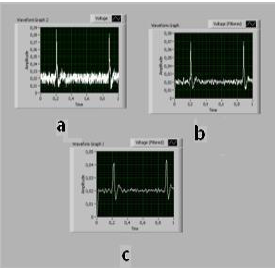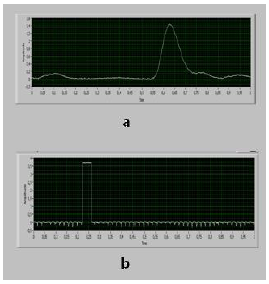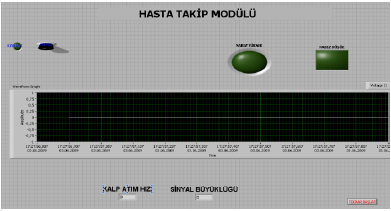- Document History
- Subscribe to RSS Feed
- Mark as New
- Mark as Read
- Bookmark
- Subscribe
- Printer Friendly Page
- Report to a Moderator
- Subscribe to RSS Feed
- Mark as New
- Mark as Read
- Bookmark
- Subscribe
- Printer Friendly Page
- Report to a Moderator
A SYSTEM DESIGN FOR TRANSMISSION OF THE BIOELECTRICAL SIGNALS OF AFTER-SURGERY PATIENTS BY USING RADIO FREQUENCY COMMUNICATION
by
T. Bayrak
1, L. Ozparlak2, O. Kocak1, A. Kocoglu3
1 Baskent University, Biomedical Engineering Dept.
2 Baskent University, Electrical-Electronics Engineering Dept.
3 Baskent University, Vocational School of Technology Biomedical Tech. Pr.
Products used:
Data Acquisition Card (NI-USB 6009), LABVIEW
TM Version 8.5
The Challenge:
Developing a system to measure ECG signal and heart rate data from patient and also transmitting of data using RF communication methods. Observation of patient in real time is available in this study.
The Solution:
To construct bioinstrumentation circuits to measure body signals (i.e. ECG signal or heart rate) from patient. To transfer the data to NI USB-6009 DAQ card by RF transmitter-receiver pair and to display the signals in LABVIEW environment with a user interface in real time.
Abstract
After surgery, the patients must walk to dispose the effect of anesthesia they have received during the surgery. Throughout the disposal of anesthesia, the physiological signal values of the patients can vary rapidly and it may be necessary to interfere in the patient in order not to have unwanted results for their health. In this study, a system which measures and transmits the physiological signals of a single patient to a nurse or doctor monitoring room was developed to be able to observe the patient on real time after surgery. Developed system has two modules: a portable module on patient and an immobile module in the monitoring room. In addition, the system compares measured heart rate values with standard values, which are different for each person’s age, and the portable module has sound alarm circuit to warn the patient for abnormal situations on patient’s physiological values. In the monitoring room, the received signal processed on software and the same alarm is monitored. In order to transmit physiological signals of the patients to the monitoring room, ECG measurement and sphygmometer circuits and radio frequency (RF) communication protocol were developed. In this project, Data Acquisition Card (NI-USB 6009) and LabVIEW software by National Instrument were used to monitor the transmitted data on the computer. In the design, RF communication is done by Amplitude Shift Keying (ASK).
Introduction
The process of after surgery is as much important for patient and health officials as surgery process. The physiological values of patient are controlled by nurses at certain standards not to cause any complication after surgery. In this process, one of the most important problems is the difficulty of observing quick alterations in physiological values
of patient on real time by the health officials during walking activity to dispose anesthesia.
The most general and important alteration is sudden change of heart rate. Increase or decrease in heart rate and blood pressure, rhythm anomalies may appear because of anesthetic drugs and operations on the surgery [1]. The change in heart rate may cause to permanent damage on patient in these circumstances.
The goal of this work is to observe the physiological signals measured from patient by radio frequency (RF) communication. First of all, the physiological signals are measured from patient during walking after surgery and displayed on monitor using interface program. The patient and health officials are warned when an abnormal situation occurs in patient’s health.

Figure 1.
The System’s Block diagram
As it can be seen in Figure 1 there are two modules in developed system. The portable module involves all physiological electrodes, measurement circuitry and transmitter unit. The immobile module is in monitoring room and contains receiver unit including DAQ card and a user interface program [2].
Data Acquisition Card is very capable to acquire the digital or analog complex signals
The NI USB-6008 and USB-6009 are low cost entry points to NI flagship data acquisition (DAQ) devices. With plug-and-play USB connectivity, these modules are simple enough for quick measurements but versatile enough for more complex measurement applications [3]. Therefore, DAQ NI USB-6009 is selected in this study. An important problem is incompatibility between the signal frequency and sampling frequency. However, the DAQ has a high sampling rate which eliminates this incompatibility issue.

Figure 2:
Received ECG Signals
a.
with circuit supplied by city electric network b. with circuit supplied by 9 volt battery
c.
Filtered ECG with 8 points Moving Average Filter on LABVIEW

Figure 3:
The Measured Pulse Signal by DAQ
a.
Original Signal
b.
Equivalent Square Wave
LABVIEW was very suitable for this real-time biomedical application with its high-speed response, enhanced tools and monitoring ability
National Instruments measurement services software, built around NI-DAQmx driver software, includes intuitive application programming interfaces, configuration tools, I/O assistants, and other tools designed to reduce system setup, configuration, and development time. National instruments recommend using the latest version of NI-DAQmx driver software for application development in NI LABVIEW, LABVIEW Signal Express, Lab Windows/CVI, and Measurement Studio software [3]. These properties were very important credentials to create user interface program in LABVIEW.

Figure 4.
The measured physiological signals are filtered to remove the noise by using Signal Express module of LABVIEW. This module involves filtering, processing tools etc. which are very useful for that kind of applications. In addition, LABVIEW contains a lot of elements and tools which make the development of user interface program easier and functional.
The User Interface ProgramReferences
[1] Schwiebert, L., Gupta, S.K.S. and Weinmann, J., "Research challenges in wireless networks of biomedical sensors"
Proceedings of the 7th annual international conference on Mobile computing and networking, p.151-165, July 2001, Rome, Italy.
[2] Prakash, Y., Lalwani, S., Gupta, S.K.S., Elsharawy, E., and Schwiebert, L. "Towards a propagation model for wireless biomedical applications,"
in Proceedings of the IEEE International Conference on Communications (ICC '03), vol. 3, pp. 1993-1997, Anchorage, Alaska, USA, May 2003.
[3] Low-Cost, Bus-Powered Multifunction DAQ for USB –12- or 14-Bit, up to 48 kS/s, 8 Analog Inputs Overview and Applications Datasheet, National Instruments, 2008
